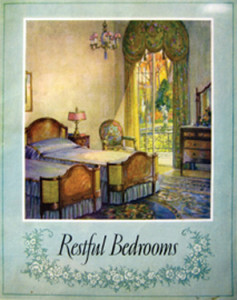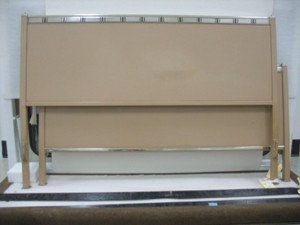The Lure of Enameled Steel in the Interwar Period
EMERGING SCHOLARS > SUMMER RESEARCH GRANTS
By Dalila Huerta
In 1933, the Simmons Company of Chicago, IL exhibited a steel bedroom ensemble at the Century of Progress World’s Fair. The ensemble, originally designed in 1929 by Norman Bel Geddes, featured a streamlined enameled steel vanity, dresser, and bed frame with sleek chrome-finished accents. The Simmons Company enjoyed a reputation as the leading seller of steel bedroom furniture at the time of the exhibition, having introduced the first metal bedroom ensemble in the world in 1923 followed by a successful advertising campaign marketed towards the upper middle-class market. With sales exceeding $50 million during the height of their popularity, it is tempting to translate the company’s success into the eager adoption of streamlined steel furniture by a wealthy middle-class during the interwar period.1
This summer, thanks to generous support from the Decorative Arts Trust, I visited the company records at the Archive Center of Smithsonian National Museum of American History to explore the alleged popularity of steel furniture. While the records at NMAH sustained the company’s popularity, the products that emerged as “popular sellers” were not the streamlined designs by Bel Geddes, but those that featured “chromopathic” enamel finishes instead.2
The Simmons Company produced a variety of metal beds, from the Bel Geddes designs frequently showcased in museum collections, to the forgotten but more popular steel reproductions of Windsor, Chippendale, and Sheraton styles. These beds were enameled in color finishes or in wood-imitating enamel in Mahogany, Chestnut, American Walnut, or Maple.3 Both finishes camouflaged or subdued the look and feel of steel, removing the sleek, industrial finish promoted by streamlined design. Even the Bel Geddes design used warm, sand-colored enamel that softened the contrast between the enamel and chrome finishes, but even this attempt did not lead to popular sales. The Bel Geddes designs remained nearly absent from most Simmons advertisements and records, until the post-war period when the company launched its “Modernization Bureau.”4
Popular Simmons beds were sold under a veil of healthful promise, advertised for their chromopathic qualities that stressed the psychosomatic necessity of a “restful bedroom” based on color. “The nervous system responds to color very much as it does to music,” claimed Simmons’ Color Therapy manual. “The mind craves something more positive than barren white, with its suggestion of winter coldness. It needs objects of interest, and above all the warmth and repose that color alone can furnish.”5
The exploitation of the perceived benefits of color in the marketing of domestic steel reveals a different layer of interwar consumption. The rejection of the visible characteristics of industrial steel and the embrace of the psychosomatic comforts of enamel demonstrate a genuine reluctance to accept the infiltration of industrialization within the most private space of the home. Popular Simmons beds serve as a window into this often overlooked characteristic of interwar domestic life, and present an alternative story to that represented by current holdings of many museum collections.
Footnotes
1 Company history and statistics from the Simmons Company Report to Stockholders for 1946 (New York: Simmons Co., 1946).
2 The term “chromopathic” first used in Simmons’ Color Therapy (New York: Simmons Co., 1925), p. 2.
3 Enameling options featured in trade catalogs and advertisements from 1916-1940.
4 Simmons Company Report to Stockholders for 1946 (New York: Simmons Co., 1946), p. 28.
5 Color Therapy (New York: Simmons Co., 1925), p. 2.
SAVE THE DATE
- Special Symposium
“Classical Splendor”
The Philadelphia Museum of Art
November 4, 2016 - New York Antiques Weekend
January 20-21, 2017 - Spring Symposium
Savannah
April 21-24, 2017 - Spring Study Trip Abroad
Scotland
May 14-22, 2017 - Fall Symposium
Hartford & Western Connecticut
September 2017 - Fall Study Trip Abroad
Venice and the Veneto
October 9-16 and 22-29, 2017
By Dalila Huerta
In 1933, the Simmons Company of Chicago, IL exhibited a steel bedroom ensemble at the Century of Progress World’s Fair. The ensemble, originally designed in 1929 by Norman Bel Geddes, featured a streamlined enameled steel vanity, dresser, and bed frame with sleek chrome-finished accents. The Simmons Company enjoyed a reputation as the leading seller of steel bedroom furniture at the time of the exhibition, having introduced the first metal bedroom ensemble in the world in 1923 followed by a successful advertising campaign marketed towards the upper middle-class market. With sales exceeding $50 million during the height of their popularity, it is tempting to translate the company’s success into the eager adoption of streamlined steel furniture by a wealthy middle-class during the interwar period.1
This summer, thanks to generous support from the Decorative Arts Trust, I visited the company records at the Archive Center of Smithsonian National Museum of American History to explore the alleged popularity of steel furniture. While the records at NMAH sustained the company’s popularity, the products that emerged as “popular sellers” were not the streamlined designs by Bel Geddes, but those that featured “chromopathic” enamel finishes instead.2
The Simmons Company produced a variety of metal beds, from the Bel Geddes designs frequently showcased in museum collections, to the forgotten but more popular steel reproductions of Windsor, Chippendale, and Sheraton styles. These beds were enameled in color finishes or in wood-imitating enamel in Mahogany, Chestnut, American Walnut, or Maple.3 Both finishes camouflaged or subdued the look and feel of steel, removing the sleek, industrial finish promoted by streamlined design. Even the Bel Geddes design used warm, sand-colored enamel that softened the contrast between the enamel and chrome finishes, but even this attempt did not lead to popular sales. The Bel Geddes designs remained nearly absent from most Simmons advertisements and records, until the post-war period when the company launched its “Modernization Bureau.”4
Popular Simmons beds were sold under a veil of healthful promise, advertised for their chromopathic qualities that stressed the psychosomatic necessity of a “restful bedroom” based on color. “The nervous system responds to color very much as it does to music,” claimed Simmons’ Color Therapy manual. “The mind craves something more positive than barren white, with its suggestion of winter coldness. It needs objects of interest, and above all the warmth and repose that color alone can furnish.”5
The exploitation of the perceived benefits of color in the marketing of domestic steel reveals a different layer of interwar consumption. The rejection of the visible characteristics of industrial steel and the embrace of the psychosomatic comforts of enamel demonstrate a genuine reluctance to accept the infiltration of industrialization within the most private space of the home. Popular Simmons beds serve as a window into this often overlooked characteristic of interwar domestic life, and present an alternative story to that represented by current holdings of many museum collections.
Footnotes
1 Company history and statistics from the Simmons Company Report to Stockholders for 1946 (New York: Simmons Co., 1946).
2 The term “chromopathic” first used in Simmons’ Color Therapy (New York: Simmons Co., 1925), p. 2.
3 Enameling options featured in trade catalogs and advertisements from 1916-1940.
4 Simmons Company Report to Stockholders for 1946 (New York: Simmons Co., 1946), p. 28.
5 Color Therapy (New York: Simmons Co., 1925), p. 2.




